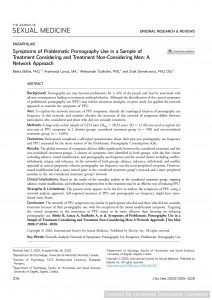Mental Health
Symptoms of Problematic Pornography Use in a Sample of Treatment Considering and Treatment Non-Considering Men
 Full Article Name: Symptoms of Problematic Pornography Use in a Sample of Treatment Considering and Treatment Non-Considering Men
Full Article Name: Symptoms of Problematic Pornography Use in a Sample of Treatment Considering and Treatment Non-Considering Men
Open Access: No
Abstract
Background: Pornography use may become problematic for 1–6% of the people and may be associated with adverse consequences leading to treatment-seeking behavior. Although the identification of the central symptoms of problematic pornography use (PPU) may inform treatment strategies, no prior study has applied the network approach to examine the symptoms of PPU. Aim: To explore the network structure of PPU symptoms, identify the topological location of pornography use frequency in this network, and examine whether the structure of this network of symptoms differs between participants who considered and those who did not consider treatment. Methods: A large-scale online sample of 4,253 men ( M age = 38.33 years, SD = 12.40) was used to explore the structure of PPU symptoms in 2 distinct groups: considered treatment group ( n = 509) and not-considered treatment group ( n = 3,684). Outcomes: Participants completed a self-report questionnaire about their past-year pornography use frequency and PPU measured by the short version of the Problematic Pornography Consumption Scale. Results: The global structure of symptoms did not differ significantly between the considered treatment and the not-considered treatment groups. 2 clusters of symptoms were identified in both groups, with the first cluster including salience, mood modification, and pornography use frequency and the second cluster including conflict, withdrawal, relapse, and tolerance. In the networks of both groups, salience, tolerance, withdrawal, and conflict appeared as central symptoms, whereas pornography use frequency was the most peripheral symptom. However, mood modification had a more central place in the considered treatment group’s network and a more peripheral position in the not-considered treatment group’s network. Clinical Implications: Based on the results of the centrality analysis in the considered treatment group, targeting salience, mood modification, and withdrawal symptoms first in the treatment may be an effective way of reducing PPU. Strengths & Limitations: The present study appears to be the first to analyze the symptoms of PPU using a network analytic approach. Self-reported measures of PPU and pornography use frequency might have introduced some biases. Conclusion: The network of PPU symptoms was similar in participants who did and those who did not consider treatment because of their pornography use, with the exception of the mood modification symptom. Targeting the central symptoms in the treatments of PPU seems to be more effective than focusing on reducing pornography use.
Citation
Bőthe B, Lonza, A., Štulhofer A, & Demetrovics, Z. (2020). Symptoms of problematic pornography use in a sample of treatment considering and treatment non-considering men: A network approach. The Journal of Sexual Medicine, 2020 Jul 13. https://doi.org/10.1016/j.jsxm.2020.05.030
